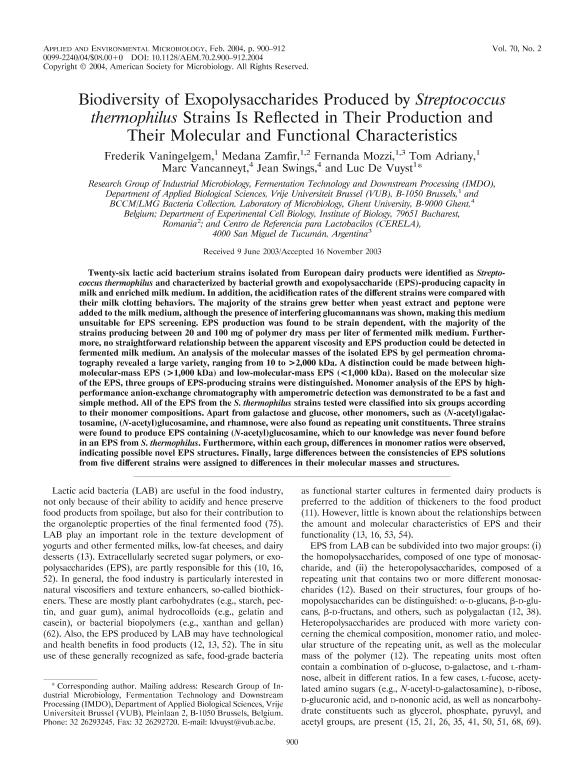Mostrar el registro sencillo del ítem
dc.contributor.author
Frederik Vaningelgem
dc.contributor.author
Zamfir, Medana
dc.contributor.author
Mozzi, Fernanda Beatriz

dc.contributor.author
Adriany, Tom
dc.contributor.author
Vancanneyt, Marc
dc.contributor.author
Swings, Jean
dc.contributor.author
De Vuyst, Luc
dc.date.available
2018-08-27T20:14:31Z
dc.date.issued
2004-02
dc.identifier.citation
Frederik Vaningelgem; Zamfir, Medana; Mozzi, Fernanda Beatriz; Adriany, Tom; Vancanneyt, Marc; et al.; Biodiversity of Exopolysaccharides Produced by Streptococcus thermophilus Strains Is Reflected in Their Production and Their Molecular and Functional Characteristics; American Society for Microbiology; Applied And Environmental Microbiology; 70; 2; 2-2004; 900-912
dc.identifier.issn
0099-2240
dc.identifier.uri
http://hdl.handle.net/11336/57292
dc.description.abstract
Twenty-six lactic acid bacterium strains isolated from European dairy products were identified as Streptococcus thermophilus and characterized by bacterial growth and exopolysaccharide (EPS)-producing capacity in milk and enriched milk medium. In addition, the acidification rates of the different strains were compared with their milk clotting behaviors. The majority of the strains grew better when yeast extract and peptone were added to the milk medium, although the presence of interfering glucomannans was shown, making this medium unsuitable for EPS screening. EPS production was found to be strain dependent, with the majority of the strains producing between 20 and 100 mg of polymer dry mass per liter of fermented milk medium. Furthermore, no straightforward relationship between the apparent viscosity and EPS production could be detected in fermented milk medium. An analysis of the molecular masses of the isolated EPS by gel permeation chromatography revealed a large variety, ranging from 10 to >2,000 kDa. A distinction could be made between high-molecular-mass EPS (>1,000 kDa) and low-molecular-mass EPS (<1,000 kDa). Based on the molecular size of the EPS, three groups of EPS-producing strains were distinguished. Monomer analysis of the EPS by high-performance anion-exchange chromatography with amperometric detection was demonstrated to be a fast and simple method. All of the EPS from the S. thermophilus strains tested were classified into six groups according to their monomer compositions. Apart from galactose and glucose, other monomers, such as (N-acetyl)galactosamine, (N-acetyl)glucosamine, and rhamnose, were also found as repeating unit constituents. Three strains were found to produce EPS containing (N-acetyl)glucosamine, which to our knowledge was never found before in an EPS from S. thermophilus. Furthermore, within each group, differences in monomer ratios were observed, indicating possible novel EPS structures. Finally, large differences between the consistencies of EPS solutions from five different strains were assigned to differences in their molecular masses and structures.
dc.format
application/pdf
dc.language.iso
eng
dc.publisher
American Society for Microbiology

dc.rights
info:eu-repo/semantics/openAccess
dc.rights.uri
https://creativecommons.org/licenses/by-nc-sa/2.5/ar/
dc.subject
Streptococcus Thermophilus
dc.subject
Exopolysaccharides
dc.subject.classification
Ciencias Medioambientales

dc.subject.classification
Ciencias de la Tierra y relacionadas con el Medio Ambiente

dc.subject.classification
CIENCIAS NATURALES Y EXACTAS

dc.subject.classification
Biología Celular, Microbiología

dc.subject.classification
Ciencias Biológicas

dc.subject.classification
CIENCIAS NATURALES Y EXACTAS

dc.title
Biodiversity of Exopolysaccharides Produced by Streptococcus thermophilus Strains Is Reflected in Their Production and Their Molecular and Functional Characteristics
dc.type
info:eu-repo/semantics/article
dc.type
info:ar-repo/semantics/artículo
dc.type
info:eu-repo/semantics/publishedVersion
dc.date.updated
2018-08-21T14:04:12Z
dc.identifier.eissn
1098-5336
dc.journal.volume
70
dc.journal.number
2
dc.journal.pagination
900-912
dc.journal.pais
Estados Unidos

dc.journal.ciudad
Washington DC
dc.description.fil
Fil: Frederik Vaningelgem. Vrije Universiteit Brussel. Department of Applied Biological Sciences. Research Group of Industrial Microbiology, Fermentation Technology and Downstream Processing; Bélgica
dc.description.fil
Fil: Zamfir, Medana. Vrije Universiteit Brussel. Department of Applied Biological Sciences. Research Group of Industrial Microbiology, Fermentation Technology and Downstream Processing; Bélgica. Institute of Biology. Department of Experimental Cell Biology; Rumania
dc.description.fil
Fil: Mozzi, Fernanda Beatriz. Vrije Universiteit Brussel. Department of Applied Biological Sciences. Research Group of Industrial Microbiology, Fermentation Technology and Downstream Processing; Bélgica. Consejo Nacional de Investigaciones Científicas y Técnicas. Centro Científico Tecnológico Conicet - Tucumán. Centro de Referencia para Lactobacilos; Argentina
dc.description.fil
Fil: Adriany, Tom. Vrije Universiteit Brussel. Department of Applied Biological Sciences. Research Group of Industrial Microbiology, Fermentation Technology and Downstream Processing; Bélgica
dc.description.fil
Fil: Vancanneyt, Marc. Ghent Universit. Laboratory of Microbiology. Bacteria Collection; Bélgica
dc.description.fil
Fil: Swings, Jean. Ghent Universit. Laboratory of Microbiology. Bacteria Collection; Bélgica
dc.description.fil
Fil: De Vuyst, Luc. Vrije Universiteit Brussel. Department of Applied Biological Sciences. Research Group of Industrial Microbiology, Fermentation Technology and Downstream Processing; Bélgica
dc.journal.title
Applied And Environmental Microbiology

dc.relation.alternativeid
info:eu-repo/semantics/altIdentifier/doi/http://dx.doi.org/10.1128/AEM.70.2.900-912.2004
dc.relation.alternativeid
info:eu-repo/semantics/altIdentifier/url/https://aem.asm.org/content/70/2/900
Archivos asociados
